Stress Concentration Factors for Welded Plate T-Joints Subjected to Tensile, Bending and Shearing Loads
Abstract
1. Introduction
2. Methodology
2.1. General Assumptions
- Joint material is linear elastic, isotropic, and homogeneous.
- Elastic properties of the weld material and the base material, represented by elastic constants, are the same.
- The welded joint is free from residual stresses, structural irregularities, and imperfections, including lack of penetration defects.
- Both welds are symmetrical with respect to the axis of the attachment plate, which is perpendicular to the main plate.
- Weld faces are plane and contour of the weldment is smooth with a transition toe radius ρ > 0.
- External load – axial, bending, and shearing – is applied at the opposite sides of the main plate sufficiently far from the welds.
- Small deformations occur in the whole body.
- Five geometrical parameters: ρ, a, θ, t, and T are considered as independent variables varying in the following ranges: 0 < ρ/a ≤ 1.3, 0 < a/t ≤ 1.3, 1 ≤ T/a ≤ 4, and 30° ≤ θ ≤ 60°.
- Stress concentration factors for axial, bending, and shearing loads are defined as Ktt = σ1max/σt, Ktb = σ1max/σb, and Kts = τmax/τs, respectively.
2.2. General Approach
3. Numerical FEM Modelling and Some SCFs’ Results
3.1. Tensile and Bending Load
3.2. Shearing Load
4. SCF Approximation Formulas
4.1. Numerical and Graphical Representation of P Functions
4.2. Validation of the P Functions
4.3. Determination of the Correction Functions κ
4.4. Validation of SCF Approximation Functions
5. Discussion
6. Conclusions
- (a)
- comparative studies of stress concentration in various geometrical forms of welded T-joints, including the use of fictitious values of the weld toe radii,
- (b)
- hot spot method applied in fatigue design of such joints,
- (c)
- weight function method used in fracture mechanics models for crack initiated at the weld toe,
- (d)
- dealing with the necessity of additional mechanical improvements in the weld toe region.
Author Contributions
Funding
Institutional Review Board Statement
Informed Consent Statement
Data Availability Statement
Acknowledgments
Conflicts of Interest
Nomenclature
| a | theoretical weld throat thickness |
| G | shear modulus |
| h, hp | leg lengths defining the weld size |
| k | thermal conductivity |
| Kt | stress concentration factor (SCF) |
| Ktt | stress concentration factor for tensile (axial) load |
| Ktb | stress concentration factor for bending load |
| Kts | stress concentration factor for shearing load |
| m, p | exponents dependent on the loading mode |
| n | stress field exponent for a sharp corner for axial and bending load |
| ns | stress field exponent for a sharp corner subjected to shearing load |
| P | regular function represented by polynomials |
| Pt, Pb, Ps | functions P corresponding to tensile, bending, and shearing load, respectively |
| q | magnitude of the heat flux |
| qmax | magnitude of the maximum heat flux |
| qnom | magnitude of the nominal heat flux at the end of the body |
| t | thickness of the main plate |
| T | thickness of the attachment plate |
| Ttemp | temperature |
| W | displacement component corresponding to the anti–plane shear |
| X = ρ/(ρ + a) | normalized toe radius parameter |
| Y = a/(a + t) | normalized weld thickness parameter |
| Z = T/a | normalized attachment plate thickness parameter |
| Z0 | arbitrarily chosen reference T/a value |
| |∇Ψ| | magnitude of the displacement (temperature) gradient |
| |∇Ψ|max | magnitude of the maximum displacement (temperature) gradient |
| |∇Ψ|nom | magnitude of the nominal displacement (temperature) gradient |
| θ | weld angle |
| κ | correction function for the relative attachment plate thickness T/a |
| κt | correction function κ for tensile (axial) load |
| κb | correction function κ for bending load |
| κs | correction function κ for shearing load |
| Ψ(x,y) | potential function representing temperature or anti–plane displacement |
| ∂Ψ/∂n | normal derivative at the bounding contour |
| ρ | weld toe radius |
| σ1 | first principal stress produced by normal or bending load |
| σ1max | maximum value of the first principal stress at the weld toe zone |
| σt | nominal tensile (axial) stress |
| σb | nominal bending stress |
| τmax | maximum shear stress at the weld toe due to shearing load |
| τs | nominal shear stress |
Appendix A
Approximating SCFs’ Formulas for a Welded Plate T-Joint Subjected to Axial, Bending, and Shearing Loads
Appendix B
Parametric Formulas for Calculating SCFs, while θ = 45°
Appendix C
Alternative Parametric Formulas for Calculating SCF for Plate T-Joints Subjected to Tensile and Bending Loads
References
- Gurney, T.R. Fatigue of Welded Structures, 2nd ed.; Cambridge University Press: Cambridge, UK, 1979. [Google Scholar]
- European Committee for Standardization (CES). EN 1993-1-9:2005 Eurocode 3: Design of Steel Structures—Part. 1–9: Fatigue; CES: Brussels, Belgium, 2005. [Google Scholar]
- Hobbacher, A.F. The new IIW recommendations for fatigue assessment of welded joints and components—A comprehensive code recently updated. Int. J. Fatigue 2009, 31, 50–58. [Google Scholar] [CrossRef]
- Fricke, W. IIW Recommendations for the Fatigue Assessment of Welded Structures by Notch Stress Analysis; Woodhead Publishing: Cambridge, UK, 2012; pp. 2–41. [Google Scholar]
- Kranz, B.; Sonsino, C.M. Verification of FAT Values for the Application of the Notch Stress Concept with the Reference Radii Rref = 1.00 and 0.05 mm. Weld. World 2010, 54, R218–R224. [Google Scholar] [CrossRef]
- Fricke, W. IIW guideline for the assessment of weld root fatigue. Weld. World 2013, 57, 753–791. [Google Scholar] [CrossRef]
- International Standard Organization (ISO). EN ISO 9692-1:2013 Welding and Allied Processes—Types of Joint Preparation—Part. 1: Manual Metal. Arc Welding, Gas.-Shielded Metal. Arc Welding, Gas. Welding, TIG Welding and Beam Welding of Steels; International Organization for Standardization: Geneva, Switzerland, 2013. [Google Scholar]
- Zhao, X.L.; Packer, J.A. Fatigue Design Procedure for Welded Hollow Section Joints, 1st ed.; Abington Publishing: Nashville, TN, USA, 2000. [Google Scholar]
- Mashiri, R.; Zhao, X.L.; Grundy, P. Stress concentration factors and fatigue failure of welded T-connections in circular hollow sections under in-plane bending. Int. J. Struct. Stab. Dyn. 2004, 4, 403–422. [Google Scholar] [CrossRef]
- Kršćanski, S.; Turkalj, G. FEM stress concentration factors for fillet welded CHS-plate T-joint. Eng. Rev. 2012, 32, 147–155. [Google Scholar]
- Saini, D.S.; Karmakar, D.; Ray-Chaudhuri, S. A review of stress concentration factors in tubular and non-tubular joints for design of offshore installations. JOES 2016, 1, 186–202. [Google Scholar] [CrossRef]
- Carpinteri, A.; Boaretto, J.; Fortese, G.; Giordani, F.; Iturrioz, I.; Ronchei, C.; Scorza, D.; Vantadori, S. Fatigue life estimation of fillet-welded tubular T-joints subjected to multiaxial loading. Int. J. Fatigue 2017, 101, 263–270. [Google Scholar] [CrossRef]
- Niu, X.; Glinka, G. The weld profile effect on stress intensity factors in weldments. Int J. Fract. 1987, 35, 3–20. [Google Scholar]
- Bhuyan, G.; Vosikovsky, O. Prediction of fatigue crack initiation lives for welded plate T-joints based on the local stress-strain approach. Int. J. Fatigue 1989, 11, 153–159. [Google Scholar] [CrossRef]
- Monahan, C.C. Early Fatigue Crack Growth at Welds; WIT PRESS/Computational Mechanics Publications: Southampton, UK, 1995. [Google Scholar]
- Ushirokawa, O.; Nakayama, E. Stress concentration factor at welded joints. Ishikawajima Harima Eng. Rev. 1983, 23, 351–355. [Google Scholar]
- Tsuji, I. Estimation of stress concentration factor at weld toe of non-load carrying fillet welded joints. Trans. West. Jpn. Soc. Nav. Archit. 1990, 80, 241–251. [Google Scholar]
- Iida, K.; Uemura, T. Stress concentration factor formulas widely used in Japan. Fatigue Fract. Eng. Mater. Struct. 1996, 19, 779–786. [Google Scholar] [CrossRef]
- Brennan, F.P.; Peletiesa, P.; Hellierb, A.K. Predicting weld toe stress concentration factors for T and skewed T-joint plate connections. Int. J. Fatigue 2000, 22, 573–584. [Google Scholar] [CrossRef]
- Dabiri, M.; Ghafouri, M.; Raftar, H.R.R.; Björk, T. Neural network-based assessment of the stress concentration factor in a T-welded joint. J. Constr. Steel Res. 2017, 128, 567–578. [Google Scholar] [CrossRef]
- Bell, R.; Vosikovsky, O.; Bain, S.A. The significance of weld toe undercuts in the fatigue of steel plate T-joints. Int. J. Fatigue 1989, 11, 3–11. [Google Scholar] [CrossRef]
- Hou, C.Y. Fatigue analysis of welded joints with the aid of real three-dimensional weld toe geometry. Int. J. Fatigue 2007, 29, 772–785. [Google Scholar] [CrossRef]
- Tarasiuk, P.; Molski, K.L.; Szymaniuk, A. Fatigue designing of welded agricultural wheels. Eksploat. Niezawodn. 2013, 15, 123–128. [Google Scholar]
- Zhao, W.; Hsu, W.-T. Re-Evaluation of Fatigue Thickness Effect Based on Fatigue Test Database. J. Mar. Sci. Eng. 2020, 8, 895. [Google Scholar] [CrossRef]
- Wang, Y.; Luo, Y.; Tsutsumi, S. Parametric Formula for Stress Concentration Factor of Fillet Weld Joints with Spline Bead Profile. Materials 2020, 13, 4639. [Google Scholar] [CrossRef]
- Terán, G.; Albiter, A.; Cuamatzi-Meléndez, R. Parametric evaluation of the stress concentration factors in T-butt welded connections. Eng. Struct. 2013, 56, 1484–1495. [Google Scholar] [CrossRef]
- Costa, J.D.M.; Jesus, J.S.; Loureiro, A.; Ferreira, J.A.M.; Borrego, L.P. Fatigue life improvement of mig welded aluminium T-joints by friction stir processing. Int. J. Fatigue 2014, 61, 244–254. [Google Scholar] [CrossRef]
- Luo, Y.; Ma, R.; Tsutsumi, S. Parametric formulae for elastic stress concentration factor at the weld toe of distorted butt-welded joints. Materials 2020, 13, 169. [Google Scholar] [CrossRef] [PubMed]
- Stenberg, T.; Barsoum, Z.; Hedlund, J.; Josefsson, J. Development of a computational fatigue model for evaluation of weld quality. Weld. World 2019, 63, 1771–1785. [Google Scholar] [CrossRef]
- Haagensen, P.J.; Maddox, S.J. Recommendations on Methods for Improving the Fatigue Strength of Welded Joints; Woodhead Publishing: Cambridge, UK, 2013; ISBN 9781782420644. [Google Scholar]
- Molski, K.L.; Tarasiuk, P.; Glinka, G. Stress concentration at cruciform welded joints under axial and bending loading modes. Weld. World 2020, 64, 1867–1876. [Google Scholar] [CrossRef]
- Molski, K.L.; Tarasiuk, P. Stress Concentration Factors for Butt-Welded Plates Subjected to Tensile, Bending and Shearing Loads. Materials 2020, 13, 1798. [Google Scholar] [CrossRef]
- Seweryn, A.; Molski, K.L. Elastic stress singularities and corresponding generalized stress intensity factors for angular corners under various boundary conditions. Eng. Fract. Mech. 1996, 55, 529–556. [Google Scholar] [CrossRef]
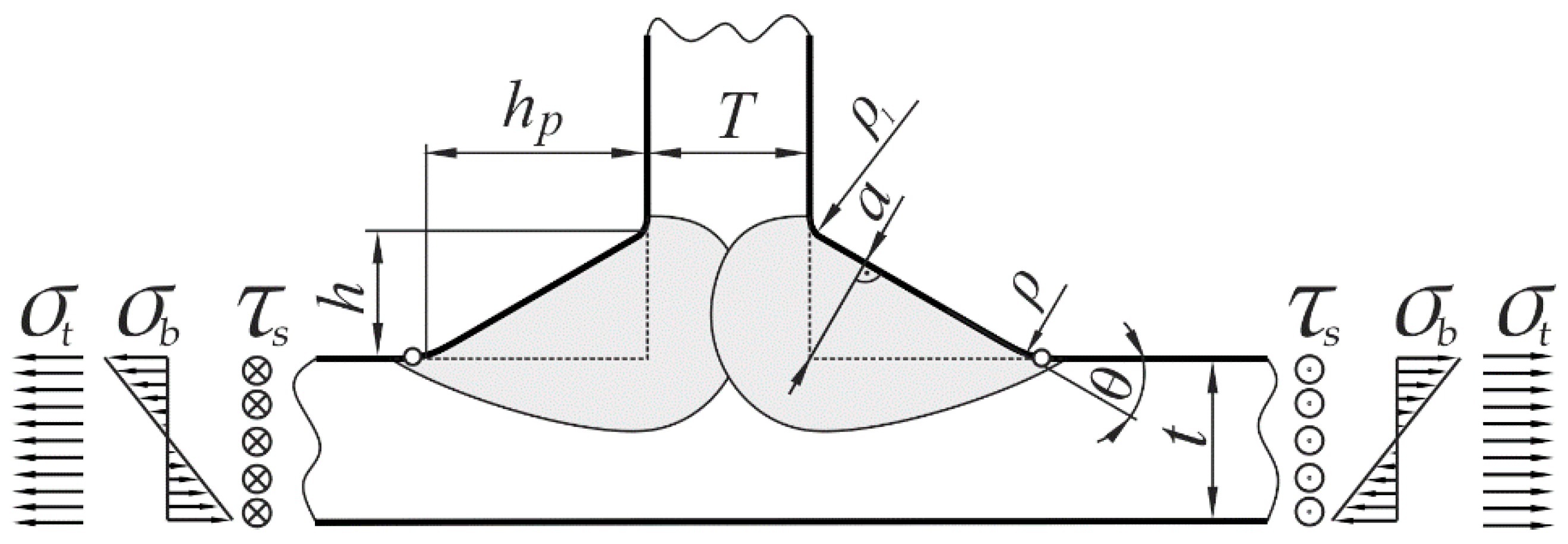
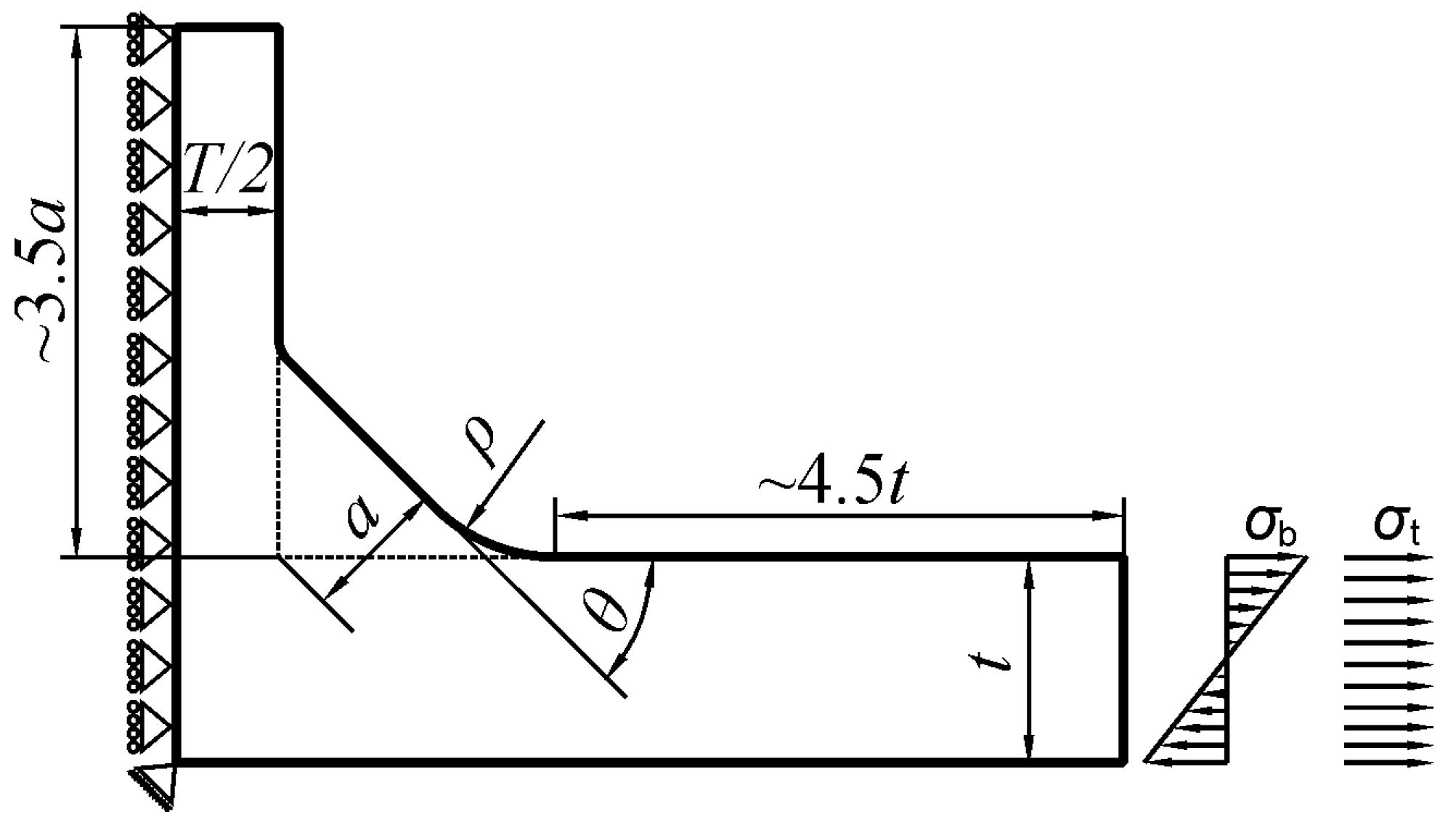
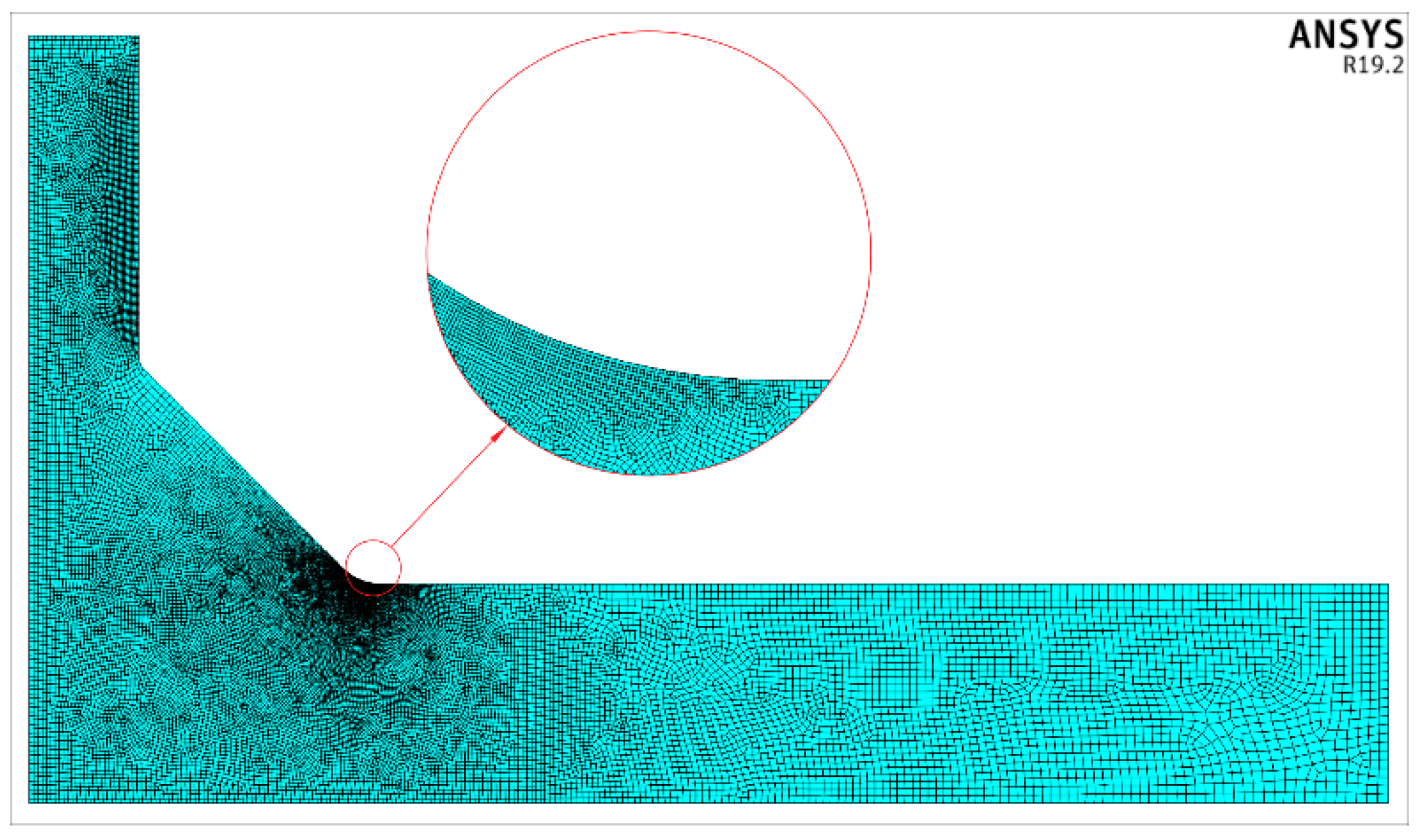
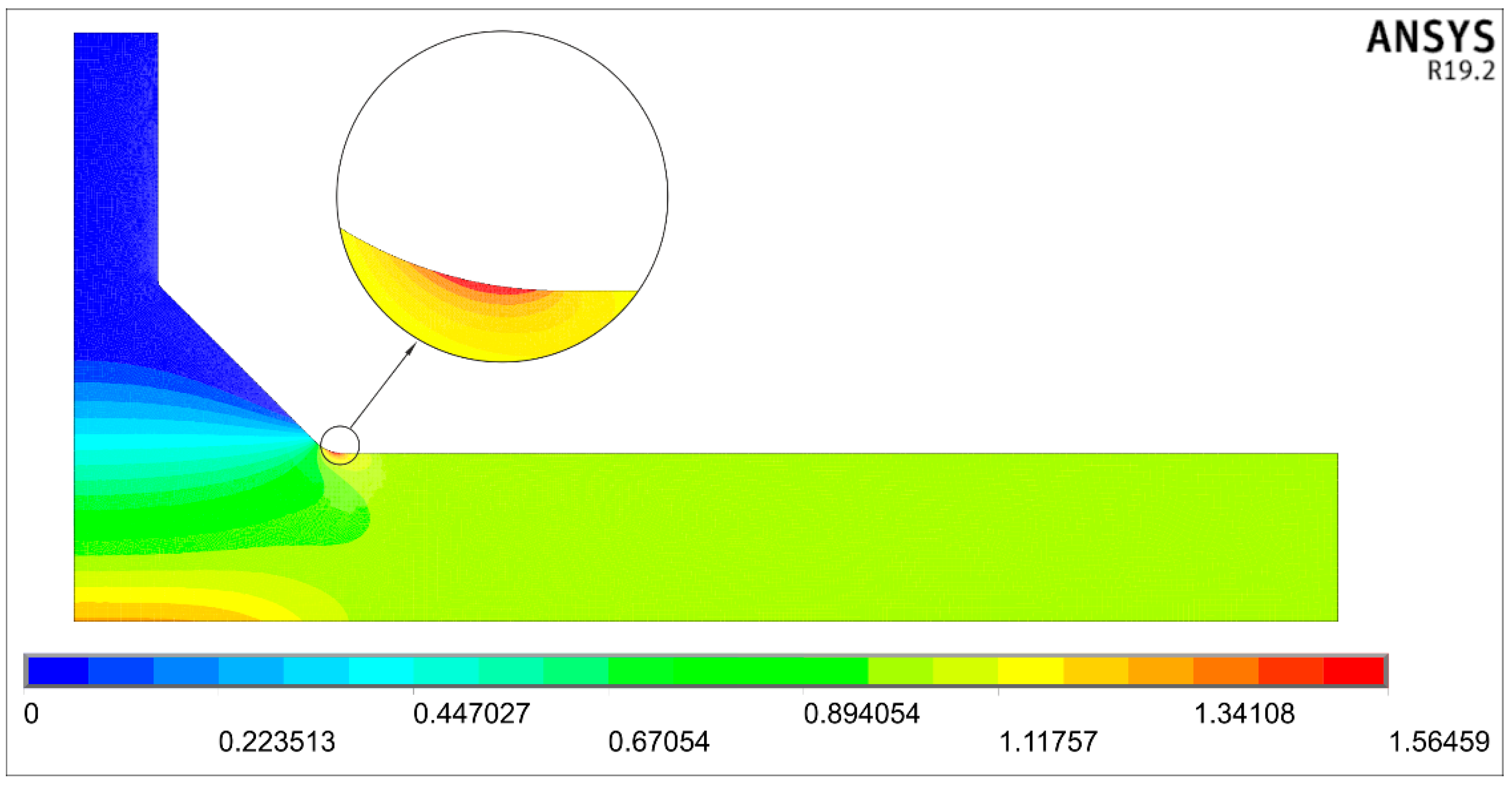
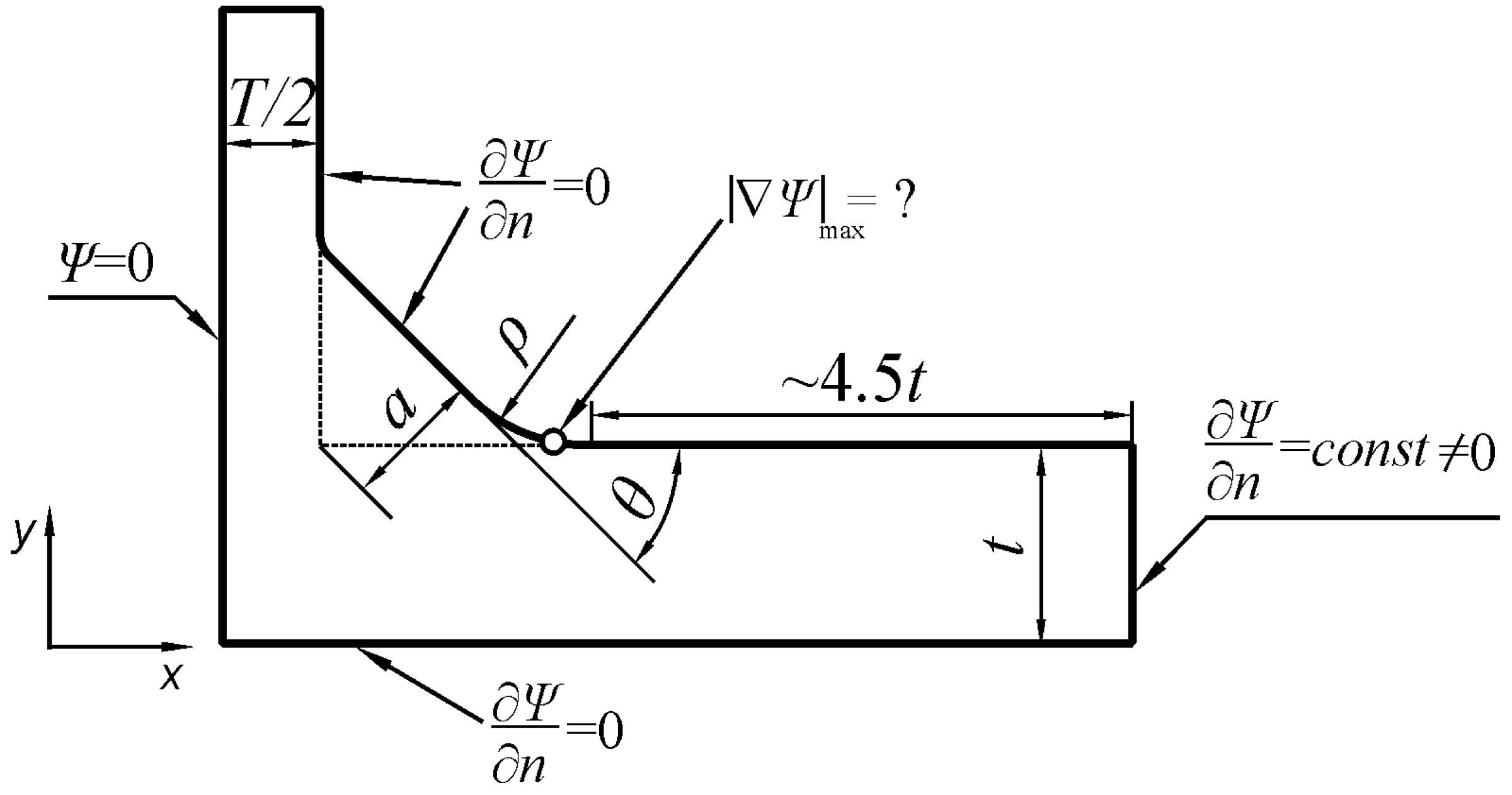
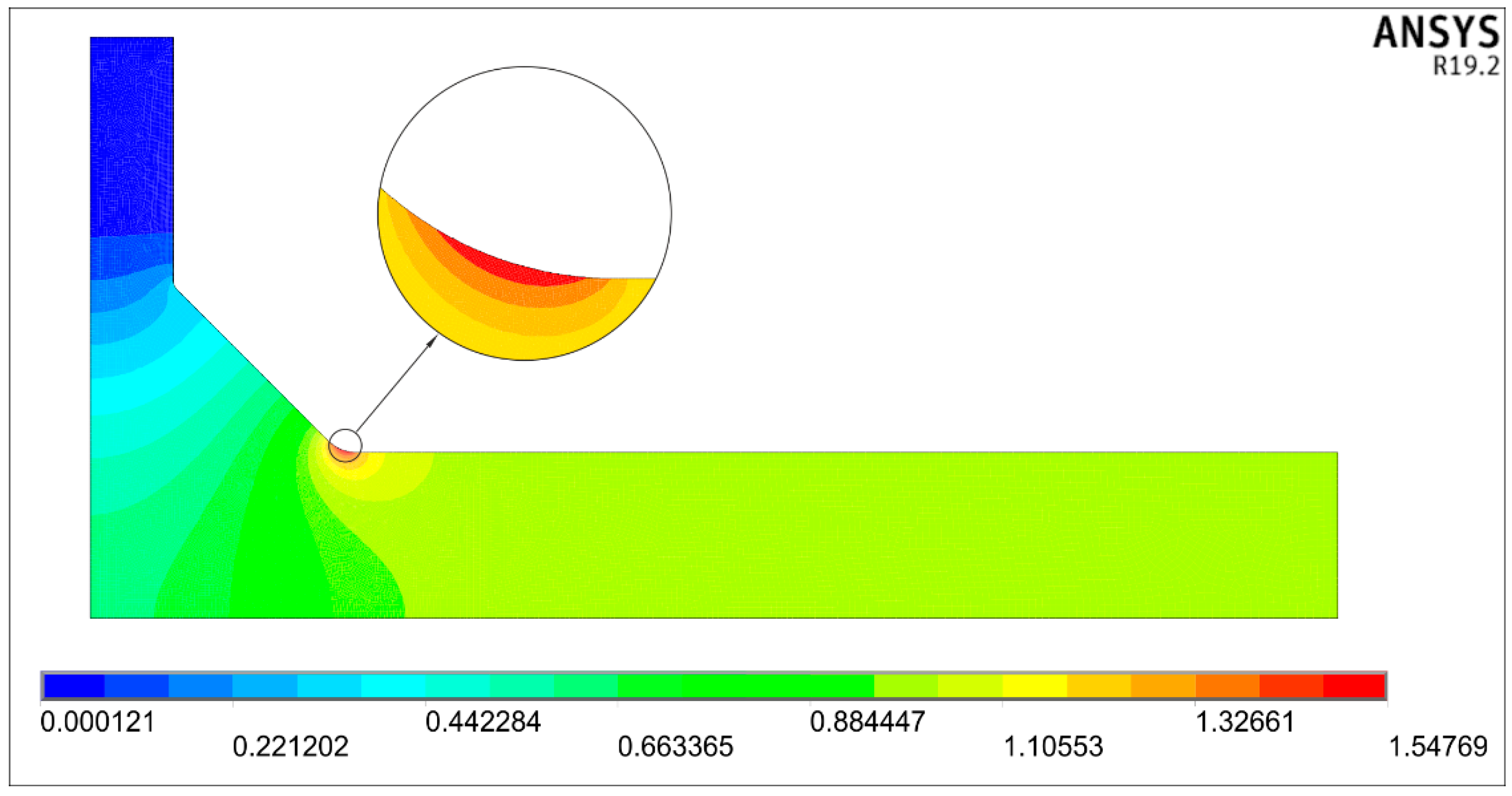
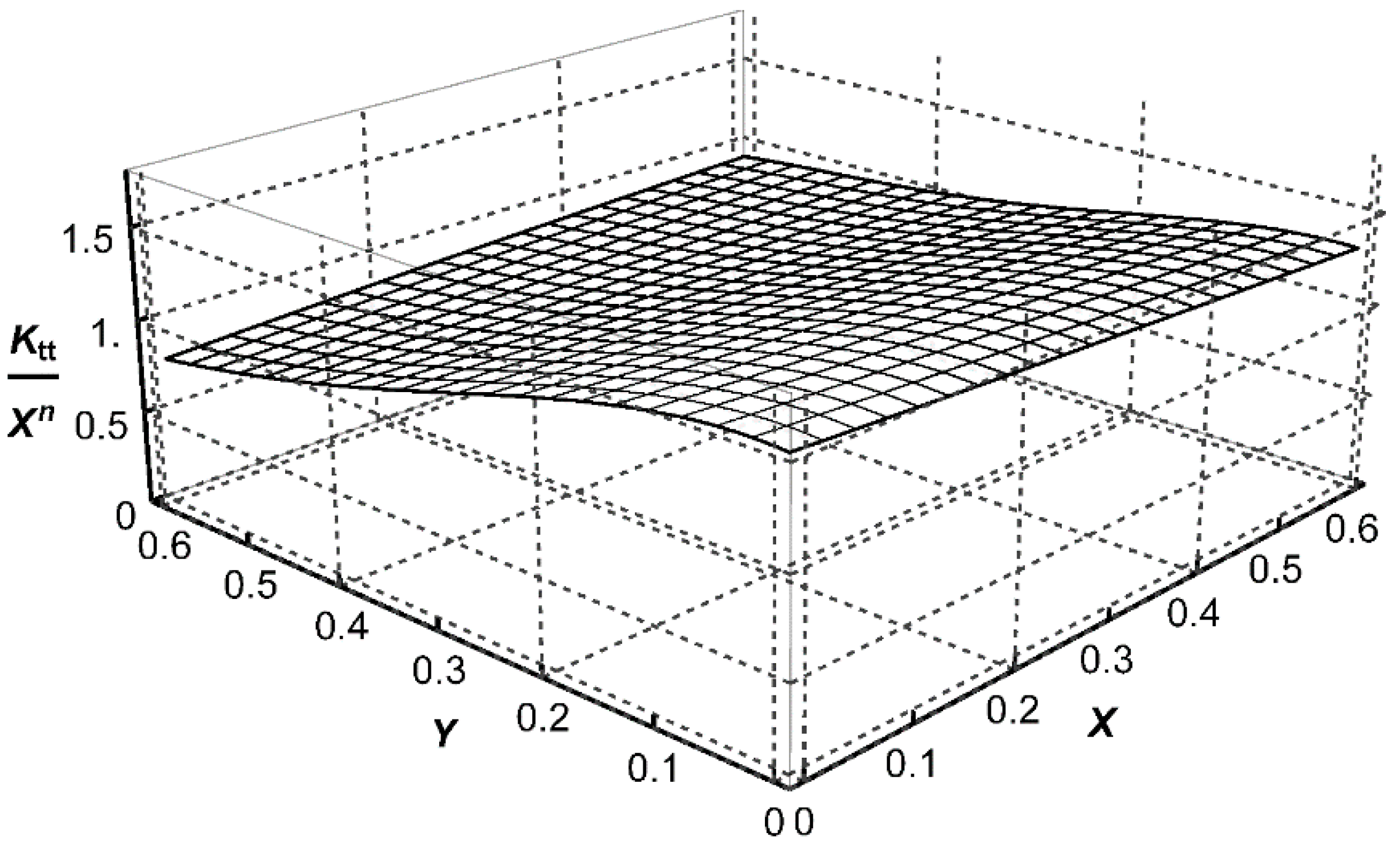
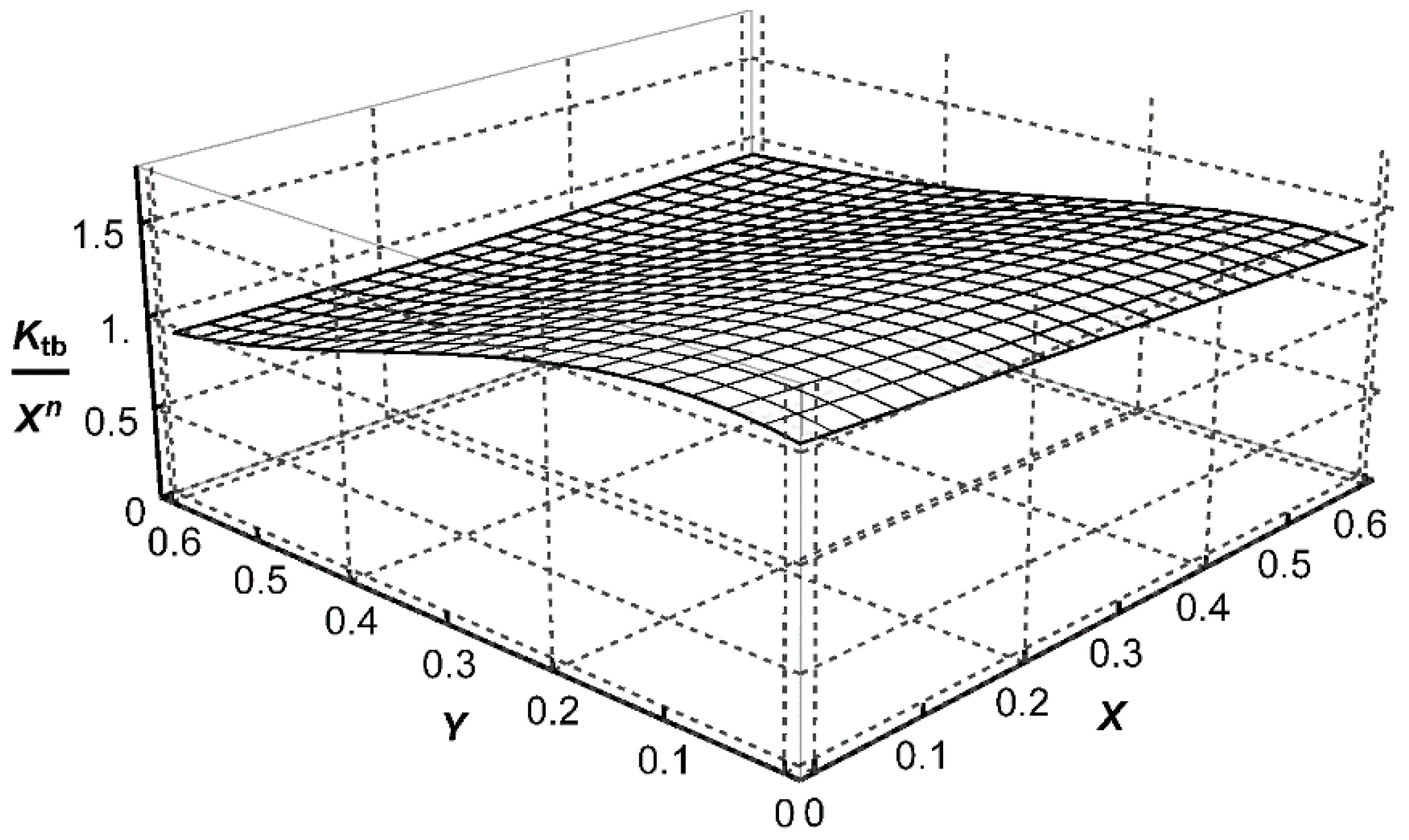
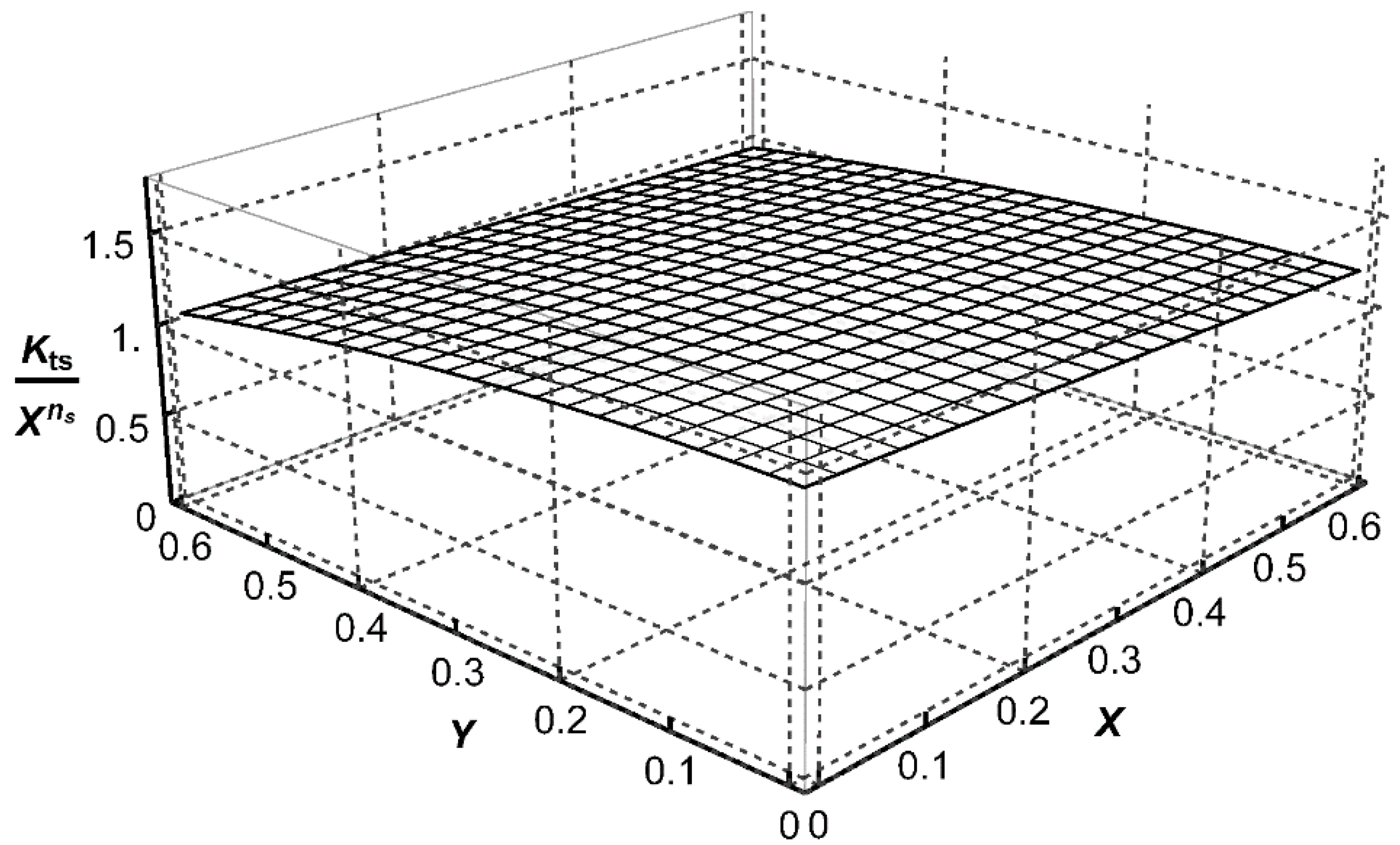
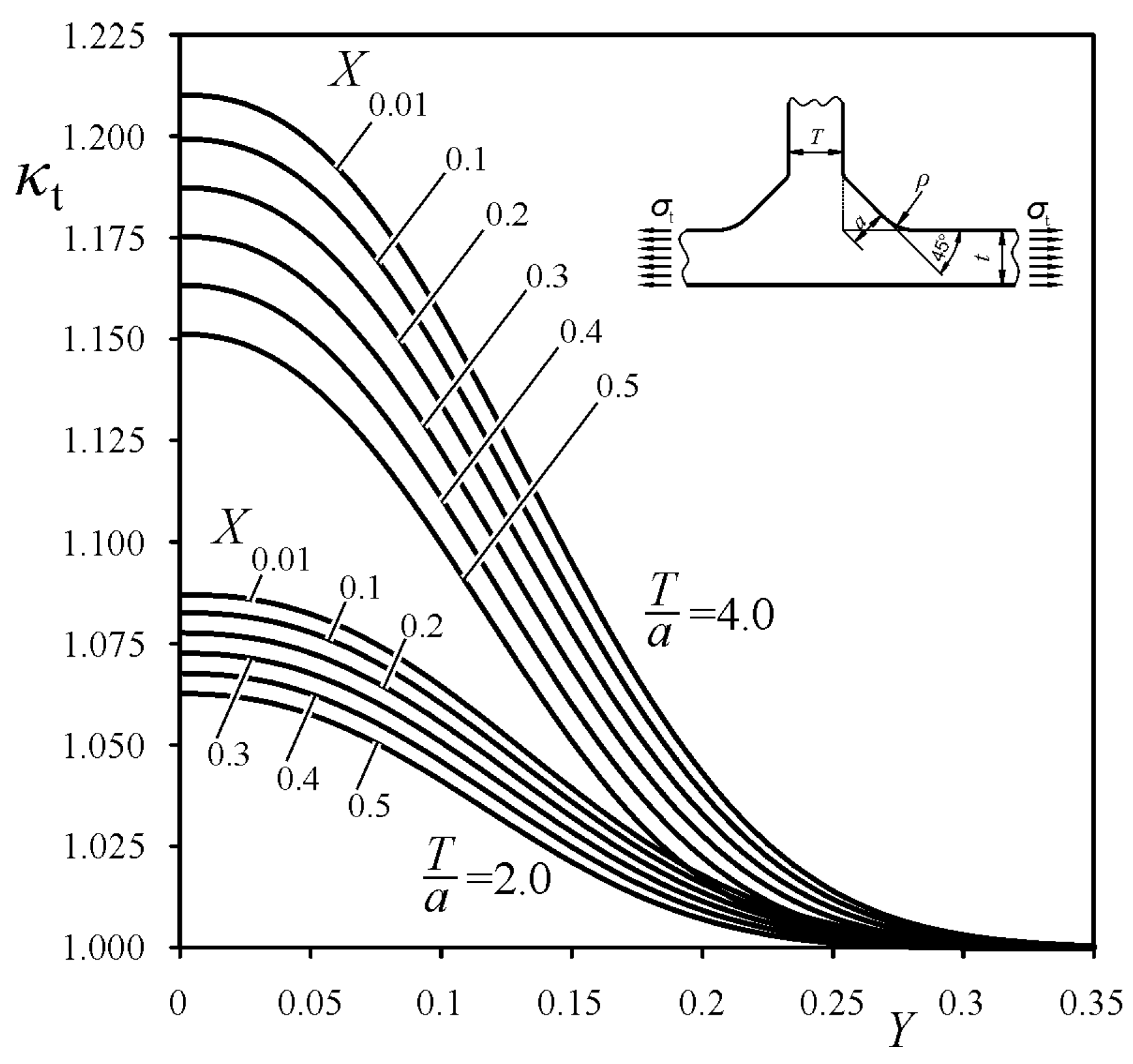
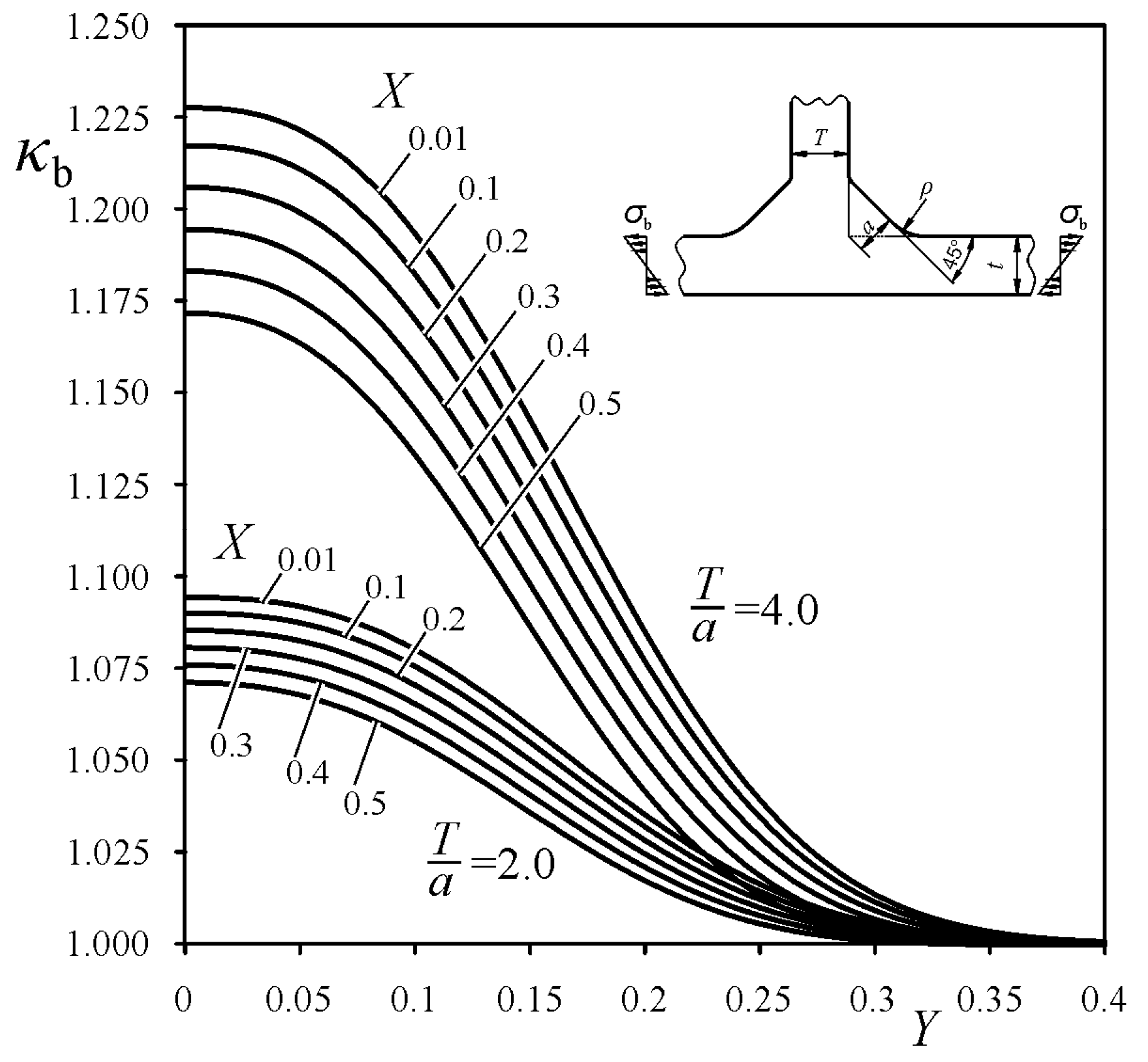
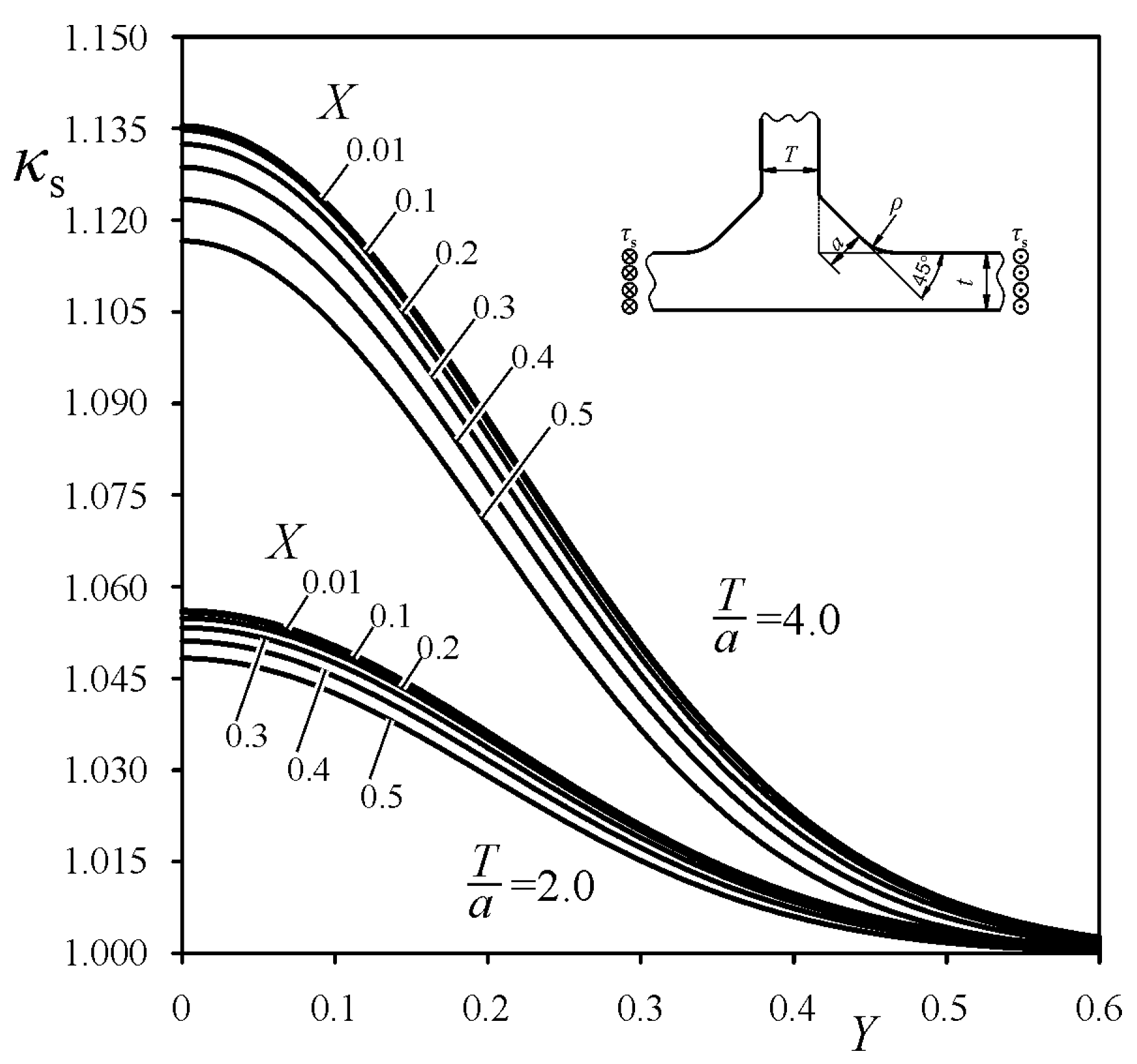
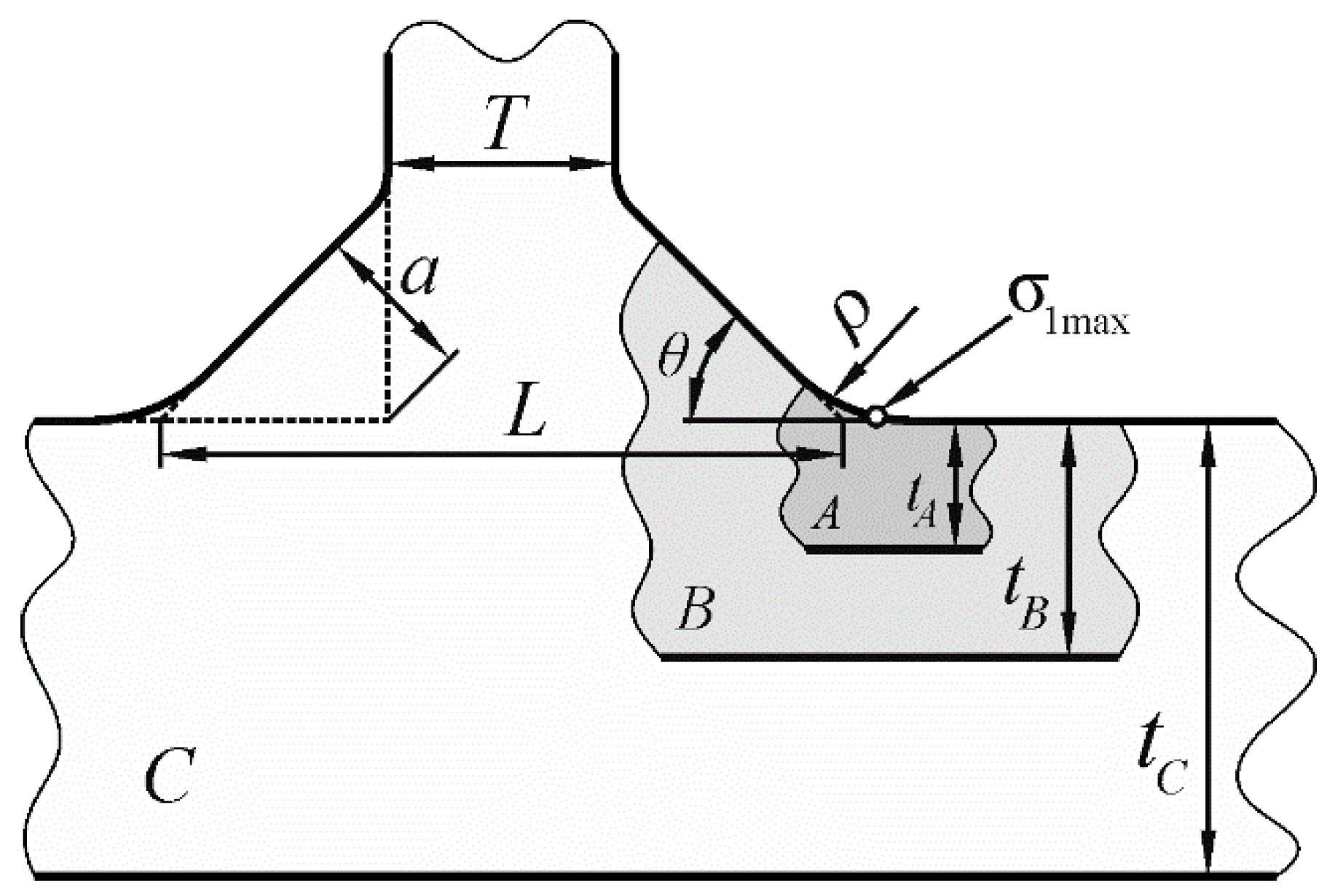
| θ = 45° | X | |||||||||||||||
|---|---|---|---|---|---|---|---|---|---|---|---|---|---|---|---|---|
| Y | 0.010 | 0.018 | 0.025 | 0.032 | 0.050 | 0.079 | 0.100 | 0.150 | 0.200 | 0.250 | 0.300 | 0.350 | 0.400 | 0.450 | 0.500 | 0.562 |
| 0.010 | 3.474 | 3.093 | 2.886 | 2.750 | 2.500 | 2.266 | 2.154 | 1.966 | 1.837 | 1.738 | 1.657 | 1.588 | 1.528 | 1.475 | 1.427 | 1.372 |
| 0.018 | 3.472 | 3.092 | 2.885 | 2.749 | 2.500 | 2.265 | 2.154 | 1.966 | 1.837 | 1.738 | 1.657 | 1.588 | 1.528 | 1.475 | 1.427 | 1.372 |
| 0.025 | 3.470 | 3.091 | 2.884 | 2.749 | 2.499 | 2.265 | 2.154 | 1.966 | 1.836 | 1.737 | 1.656 | 1.588 | 1.528 | 1.475 | 1.426 | 1.372 |
| 0.032 | 3.469 | 3.090 | 2.884 | 2.748 | 2.499 | 2.265 | 2.154 | 1.966 | 1.836 | 1.737 | 1.656 | 1.588 | 1.528 | 1.474 | 1.426 | 1.371 |
| 0.050 | 3.464 | 3.088 | 2.881 | 2.746 | 2.497 | 2.263 | 2.152 | 1.964 | 1.835 | 1.736 | 1.655 | 1.586 | 1.527 | 1.473 | 1.425 | 1.370 |
| 0.079 | 3.455 | 3.079 | 2.876 | 2.740 | 2.492 | 2.258 | 2.148 | 1.960 | 1.830 | 1.732 | 1.652 | 1.583 | 1.523 | 1.470 | 1.422 | 1.367 |
| 0.100 | 3.453 | 3.076 | 2.871 | 2.735 | 2.487 | 2.254 | 2.143 | 1.956 | 1.827 | 1.729 | 1.648 | 1.580 | 1.520 | 1.467 | 1.419 | 1.364 |
| 0.150 | 3.429 | 3.053 | 2.849 | 2.715 | 2.468 | 2.237 | 2.127 | 1.941 | 1.813 | 1.715 | 1.636 | 1.568 | 1.508 | 1.456 | 1.408 | 1.353 |
| 0.200 | 3.389 | 3.018 | 2.816 | 2.683 | 2.440 | 2.211 | 2.102 | 1.919 | 1.792 | 1.695 | 1.616 | 1.549 | 1.491 | 1.439 | 1.391 | 1.337 |
| 0.250 | 3.335 | 2.970 | 2.771 | 2.641 | 2.401 | 2.176 | 2.069 | 1.888 | 1.764 | 1.669 | 1.591 | 1.525 | 1.467 | 1.416 | 1.369 | 1.316 |
| 0.300 | 3.269 | 2.911 | 2.715 | 2.588 | 2.353 | 2.132 | 2.028 | 1.850 | 1.729 | 1.635 | 1.559 | 1.495 | 1.438 | 1.388 | 1.343 | 1.291 |
| 0.350 | 3.191 | 2.841 | 2.650 | 2.526 | 2.296 | 2.081 | 1.979 | 1.806 | 1.688 | 1.597 | 1.523 | 1.460 | 1.405 | 1.357 | 1.313 | 1.263 |
| 0.400 | 3.104 | 2.763 | 2.578 | 2.457 | 2.234 | 2.024 | 1.925 | 1.757 | 1.642 | 1.554 | 1.483 | 1.422 | 1.369 | 1.323 | 1.281 | 1.233 |
| 0.450 | 3.009 | 2.679 | 2.500 | 2.383 | 2.166 | 1.963 | 1.867 | 1.705 | 1.594 | 1.509 | 1.440 | 1.382 | 1.332 | 1.288 | 1.248 | 1.204 |
| 0.500 | 2.911 | 2.592 | 2.418 | 2.304 | 2.095 | 1.899 | 1.807 | 1.650 | 1.543 | 1.462 | 1.396 | 1.341 | 1.294 | 1.252 | 1.216 | 1.175 |
| 0.562 | 2.782 | 2.477 | 2.312 | 2.203 | 2.003 | 1.816 | 1.728 | 1.579 | 1.478 | 1.402 | 1.341 | 1.290 | 1.247 | 1.210 | 1.177 | 1.142 |
| θ = 45° | X | ||||||
|---|---|---|---|---|---|---|---|
| Y | 0.050 | 0.100 | 0.200 | 0.300 | 0.400 | 0.500 | 0.562 |
| 0.050 | 3.916 3.930 * | 3.091 3.099 * | 2.412 2.419 * | 2.070 2.075 * | 1.845 1.850 * | 1.679 1.683 * | 1.593 1.596 * |
| 0.100 | 3.848 3.854 * | 3.034 3.039 * | 2.369 2.372 * | 2.033 2.035 * | 1.812 1.813 * | 1.648 1.647 * | 1.562 1.561 * |
| 0.200 | 3.540 3.530 * | 2.793 2.785 * | 2.183 2.177 * | 1.875 1.870 * | 1.672 1.668 * | 1.520 1.517 * | 1.440 1.439 * |
| 0.300 | 3.099 3.108 * | 2.451 2.459 * | 1.927 1.933 * | 1.666 1.671 * | 1.496 1.500 * | 1.371 1.374 * | 1.307 1.309 * |
| 0.400 | 2.696 2.702 * | 2.145 2.150 * | 1.708 1.711 * | 1.496 1.497 * | 1.361 1.361 * | 1.263 1.262 * | 1.214 1.212 * |
| 0.500 | 2.379 2.374 * | 1.910 1.906 * | 1.545 1.542 * | 1.373 1.371 * | 1.265 1.264 * | 1.189 1.190 * | 1.152 1.153 * |
| 0.562 | 2.209 2.216 * | 1.784 1.790 * | 1.460 1.464 * | 1.309 1.311 * | 1.216 1.218 * | 1.152 1.152 * | 1.121 1.121 * |
| θ = 45° | X | ||||||
|---|---|---|---|---|---|---|---|
| Y | 0.050 | 0.100 | 0.200 | 0.300 | 0.400 | 0.500 | 0.562 |
| 0.050 | 3.997 4.010 * | 3.149 3.160 * | 2.455 2.463 * | 2.103 2.110 * | 1.872 1.878 * | 1.700 1.706 * | 1.611 1.616 * |
| 0.100 | 4.020 4.027 * | 3.164 3.171 * | 2.462 2.467 * | 2.104 2.108 * | 1.868 1.872 * | 1.692 1.695 * | 1.601 1.602 * |
| 0.200 | 3.868 3.856 * | 3.041 3.033 * | 2.358 2.351 * | 2.007 2.001 * | 1.773 1.768 * | 1.596 1.593 * | 1.505 1.501 * |
| 0.300 | 3.494 3.502 * | 2.746 2.753 * | 2.127 2.131 * | 1.806 1.813 * | 1.595 1.602 * | 1.440 1.444 * | 1.357 1.363 * |
| 0.400 | 3.059 3.072 * | 2.411 2.416 * | 1.873 1.876 * | 1.599 1.604 * | 1.423 1.428 * | 1.298 1.302 * | 1.236 1.240 * |
| 0.500 | 2.685 2.671 * | 2.118 2.106 * | 1.659 1.649 * | 1.435 1.426 * | 1.297 1.290 * | 1.204 1.198 * | 1.161 1.157 * |
| 0.562 | 2.469 2.482 * | 1.952 1.963 * | 1.540 1.548 * | 1.346 1.352 * | 1.231 1.236 * | 1.157 1.161 * | 1.123 1.126 * |
| θ = 45° | X | ||||||
|---|---|---|---|---|---|---|---|
| Y | 0.050 | 0.100 | 0.200 | 0.300 | 0.400 | 0.500 | 0.562 |
| 0.050 | 2.497 2.486 * | 2.152 2.143 * | 1.835 1.827 * | 1.655 1.648 * | 1.527 1.520 * | 1.425 1.418 * | 1.370 1.363 * |
| 0.100 | 2.487 2.474 * | 2.143 2.133 * | 1.827 1.818 * | 1.648 1.640 * | 1.520 1.513 * | 1.419 1.412 * | 1.364 1.357 * |
| 0.200 | 2.440 2.426 * | 2.102 2.092 * | 1.792 1.784 * | 1.616 1.609 * | 1.491 1.485 * | 1.391 1.387 * | 1.337 1.334 * |
| 0.300 | 2.353 2.346 * | 2.028 2.023 * | 1.729 1.726 * | 1.559 1.558 * | 1.438 1.439 * | 1.343 1.346 * | 1.291 1.295 * |
| 0.400 | 2.234 2.235 * | 1.925 1.927 * | 1.642 1.645 * | 1.483 1.486 * | 1.369 1.375 * | 1.281 1.288 * | 1.233 1.241 * |
| 0.500 | 2.095 2.091 * | 1.807 1.804 * | 1.543 1.541 * | 1.396 1.394 * | 1.294 1.291 * | 1.216 1.213 * | 1.175 1.172 * |
| 0.562 | 2.003 1.986 * | 1.728 1.713 * | 1.478 1.464 * | 1.341 1.326 * | 1.247 1.230 * | 1.177 1.158 * | 1.142 1.121 * |
| θ = 30° | Ktt | Ktb | Kts | ||||||||||
|---|---|---|---|---|---|---|---|---|---|---|---|---|---|
| ρ/a | t/a | T/a = 1 | T/a = 2 | T/a = 3 | T/a = 4 | T/a = 1 | T/a = 2 | T/a = 3 | T/a = 4 | T/a = 1 | T/a = 2 | T/a = 3 | T/a = 4 |
| 0.05 | 10 | 3.469 3.489 * | 3.588 3.613 * | 3.681 3.708 * | 3.754 3.788 * | 3.556 3.571 * | 3.698 3.721 * | 3.813 3.836 * | 3.907 3.933 * | 2.144 2.156 * | 2.203 2.224 * | 2.258 2.277 * | 2.306 2.321 * |
| 7 | 3.378 3.394 * | 3.462 3.471 * | 3.519 3.529 * | 3.557 3.578 * | 3.499 3.506 * | 3.607 3.612 * | 3.687 3.694 * | 3.746 3.763 * | 2.133 2.146 * | 2.186 2.207 * | 2.234 2.253 * | 2.276 2.292 * | |
| 4 | 3.110 3.129 * | 3.129 3.141 * | 3.136 3.151 * | 3.138 3.158 * | 3.278 3.284 * | 3.314 3.309 * | 3.331 3.328 * | 3.337 3.345 * | 2.092 2.113 * | 2.130 2.154 * | 2.162 2.185 * | 2.186 2.212 * | |
| 0.25 | 10 | 2.334 2.347 * | 2.413 2.426 * | 2.474 2.487 * | 2.522 2.538 * | 2.391 2.400 * | 2.485 2.498 * | 2.561 2.574 * | 2.624 2.638 * | 1.705 1.714 * | 1.752 1.768 * | 1.793 1.809 * | 1.833 1.844 * |
| 7 | 2.273 2.283 * | 2.328 2.331 * | 2.366 2.368 * | 2.390 2.399 * | 2.352 2.356 * | 2.424 2.425 * | 2.477 2.478 * | 2.515 2.523 * | 1.696 1.706 * | 1.738 1.754 * | 1.775 1.791 * | 1.808 1.822 * | |
| 4 | 2.094 2.107 * | 2.106 2.114 * | 2.110 2.120 * | 2.111 2.124 * | 2.204 2.208 * | 2.227 2.224 * | 2.238 2.236 * | 2.242 2.246 * | 1.663 1.680 * | 1.694 1.712 * | 1.718 1.737 * | 1.738 1.758 * | |
| 0.5 | 10 | 1.976 1.987 * | 2.040 2.051 * | 2.090 2.101 * | 2.129 2.142 * | 2.022 2.028 * | 2.098 2.109 * | 2.161 2.172 * | 2.214 2.225 * | 1.546 1.552 * | 1.588 1.600 * | 1.626 1.637 * | 1.661 1.668 * |
| 7 | 1.925 1.934 * | 1.969 1.972 * | 1.999 2.001 * | 2.019 2.026 * | 1.988 1.991 * | 2.047 2.047 * | 2.090 2.091 * | 2.122 2.127 * | 1.538 1.545 * | 1.575 1.588 * | 1.609 1.621 * | 1.639 1.648 * | |
| 4 | 1.775 1.788 * | 1.784 1.793 * | 1.787 1.797 * | 1.788 1.801 * | 1.863 1.866 * | 1.881 1.878 * | 1.890 1.888 * | 1.892 1.896 * | 1.508 1.522 * | 1.535 1.551 * | 1.557 1.572 * | 1.575 1.591 * | |
| 1 | 10 | 1.687 1.696 * | 1.737 1.748 * | 1.776 1.788 * | 1.807 1.821 * | 1.723 1.728 * | 1.783 1.796 * | 1.832 1.848 * | 1.874 1.892 * | 1.405 1.409 * | 1.442 1.452 * | 1.475 1.484 * | 1.506 1.512 * |
| 7 | 1.643 1.652 * | 1.677 1.682 * | 1.700 1.705 * | 1.715 1.725 * | 1.693 1.695 * | 1.738 1.741 * | 1.772 1.777 * | 1.796 1.807 * | 1.398 1.403 * | 1.430 1.441 * | 1.460 1.469 * | 1.486 1.494 * | |
| 4 | 1.519 1.534 * | 1.525 1.537 * | 1.527 1.540 * | 1.527 1.543 * | 1.584 1.588 * | 1.597 1.598 * | 1.603 1.605 * | 1.604 1.611 * | 1.371 1.383 * | 1.394 1.408 * | 1.413 1.427 * | 1.429 1.443 * | |
| θ= 45° | Ktt | Ktb | Kts | ||||||||||
| ρ/a | t/a | T/a = 1 | T/a = 2 | T/a = 3 | T/a = 4 | T/a = 1 | T/a = 2 | T/a = 3 | T/a = 4 | T/a = 1 | T/a = 2 | T/a = 3 | T/a = 4 |
| 0.05 | 10 | 3.940 3.938 * | 4.200 4.200 * | 4.404 4.402 * | 4.565 4.572 * | 4.095 4.097 * | 4.409 4.429 * | 4.670 4.684 * | 4.889 4.898 * | 2.514 2.502 * | 2.632 2.630 * | 2.735 2.728 * | 2.824 2.811 * |
| 7 | 3.865 3.853 * | 4.078 4.048 * | 4.229 4.197 * | 4.331 4.323 * | 4.081 4.074 * | 4.364 4.353 * | 4.582 4.568 * | 4.749 4.748 * | 2.504 2.490 * | 2.615 2.608 * | 2.709 2.698 * | 2.789 2.774 * | |
| 4 | 3.609 3.588 * | 3.701 3.650 * | 3.740 3.697 * | 3.754 3.736 * | 3.941 3.921 * | 4.107 4.053 * | 4.203 4.155 * | 4.256 4.240 * | 2.464 2.451 * | 2.554 2.540 * | 2.623 2.608 * | 2.677 2.665 * | |
| 0.25 | 10 | 2.380 2.384 * | 2.523 2.525 * | 2.636 2.634 * | 2.727 2.725 * | 2.456 2.470 * | 2.630 2.651 * | 2.776 2.790 * | 2.899 2.907 * | 1.829 1.820 * | 1.913 1.911 * | 1.986 1.981 * | 2.049 2.040 * |
| 7 | 2.335 2.333 * | 2.451 2.436 * | 2.533 2.514 * | 2.589 2.581 * | 2.450 2.451 * | 2.606 2.601 * | 2.727 2.715 * | 2.820 2.812 * | 1.821 1.812 * | 1.900 1.895 * | 1.967 1.959 * | 2.024 2.013 * | |
| 4 | 2.183 2.177 * | 2.230 2.207 * | 2.250 2.230* | 2.257 2.249 * | 2.358 2.351 * | 2.411 2.447 * | 2.492 2.468 * | 2.520 2.511 * | 1.792 1.784 * | 1.855 1.846 * | 1.905 1.894 * | 1.943 1.935 * | |
| 0.5 | 10 | 1.959 1.962 * | 2.063 2.066 * | 2.147 2.145 * | 2.215 2.212 * | 2.012 2.024 * | 2.140 2.158 * | 2.248 2.262 * | 2.340 2.349 * | 1.603 1.596 * | 1.673 1.672 * | 1.734 1.730 * | 1.789 1.780 * |
| 7 | 1.922 1.920 * | 2.005 1.993 * | 2.063 2.050 * | 2.104 2.097 * | 1.999 2.004 * | 2.110 2.113 * | 2.199 2.196 * | 2.266 2.267 * | 1.596 1.588 * | 1.662 1.658 * | 1.718 1.711 * | 1.766 1.756 * | |
| 4 | 1.799 1.795 * | 1.830 1.814 * | 1.842 1.829 * | 1.847 1.842 * | 1.915 1.915 * | 1.976 1.959 * | 2.010 1.993 * | 2.029 2.022 * | 1.571 1.564 * | 1.623 1.616 * | 1.664 1.655 * | 1.696 1.689 * | |
| 1 | 10 | 1.655 1.656 * | 1.726 1.730 * | 1.783 1.787 * | 1.829 1.835 * | 1.690 1.699 * | 1.777 1.798 * | 1.852 1.874 * | 1.916 1.937 * | 1.420 1.414 * | 1.475 1.475 * | 1.524 1.522 * | 1.569 1.562 * |
| 7 | 1.623 1.620 * | 1.676 1.670 * | 1.715 1.709 * | 1.741 1.741 * | 1.673 1.677 * | 1.747 1.754 * | 1.805 1.813 * | 1.851 1.863 * | 1.414 1.408 * | 1.465 1.463 * | 1.510 1.506 * | 1.549 1.542 * | |
| 4 | 1.520 1.517 * | 1.536 1.528 * | 1.543 1.536 * | 1.544 1.543 * | 1.596 1.593 * | 1.627 1.621 * | 1.646 1.642 * | 1.655 1.659 * | 1.391 1.387 * | 1.431 1.428 * | 1.462 1.458 * | 1.488 1.484 * | |
| θ = 55° | Ktt | Ktb | Kts | ||||||||||
|---|---|---|---|---|---|---|---|---|---|---|---|---|---|
| ρ/a | t/a | T/a = 1 | T/a = 2 | T/a = 3 | T/a = 4 | T/a = 1 | T/a = 2 | T/a = 3 | T/a = 4 | T/a = 1 | T/a = 2 | T/a = 3 | T/a = 4 |
| 0.05 | 10 | 4.005 4.026 * | 4.339 4.367 * | 4.604 4.628 * | 4.816 4.848 * | 4.180 4.198 * | 4.591 4.641 * | 4.939 4.981 * | 5.234 5.267 * | 2.714 2.716 * | 2.875 2.888 * | 3.011 3.020 * | 3.127 3.132 * |
| 7 | 3.941 3.951 * | 4.225 4.216 * | 4.430 4.419 * | 4.574 4.590 * | 4.193 4.220 * | 4.579 4.593 * | 4.887 4.894 * | 5.129 5.147 * | 2.703 2.703 * | 2.857 2.862 * | 2.983 2.985 * | 3.089 3.089 * | |
| 4 | 3.707 3.703 * | 3.849 3.802 * | 3.915 3.879 * | 3.938 3.943 * | 4.115 4.110 * | 4.383 4.336 * | 4.549 4.509 * | 4.649 4.656 * | 2.663 2.659 * | 2.791 2.784 * | 2.890 2.880 * | 2.965 2.961 * | |
| 0.25 | 10 | 2.347 2.359 * | 2.512 2.529 * | 2.646 2.659 * | 2.753 2.769 * | 2.426 2.437 * | 2.631 2.658 * | 2.807 2.828 * | 2.958 2.972 * | 1.878 1.879 * | 1.984 1.993 * | 2.074 2.082 * | 2.154 2.156 * |
| 7 | 2.309 2.315 * | 2.448 2.444 * | 2.548 2.543 * | 2.618 2.627 * | 2.423 2.429 * | 2.614 2.621 * | 2.767 2.767 * | 2.889 2.891 * | 1.870 1.870 * | 1.971 1.976 * | 2.055 2.058 * | 2.126 2.127 * | |
| 4 | 2.175 2.175 * | 2.239 2.219 * | 2.268 2.254 * | 2.278 2.283 * | 2.358 2.356 * | 2.484 2.459 * | 2.562 2.537 * | 2.608 2.603 * | 1.842 1.840 * | 1.926 1.923 * | 1.991 1.986 * | 2.040 2.040 * | |
| 0.5 | 10 | 1.931 1.940 * | 2.046 2.059 * | 2.139 2.149 * | 2.215 2.226 * | 1.984 1.991 * | 2.126 2.146 * | 2.250 2.265 * | 2.356 2.366 * | 1.620 1.620 * | 1.705 1.712 * | 1.778 1.782 * | 1.842 1.842 * |
| 7 | 1.899 1.904 * | 1.993 1.991 * | 2.061 2.058 * | 2.108 2.114 * | 1.974 1.978 * | 2.104 2.108 * | 2.208 2.208 * | 2.291 2.293 * | 1.613 1.612 * | 1.694 1.697 * | 1.761 1.762 * | 1.819 1.817 * | |
| 4 | 1.789 1.790 * | 1.828 1.817 * | 1.845 1.838 * | 1.851 1.855 * | 1.907 1.904 * | 1.986 1.968 * | 2.034 2.016 * | 2.062 2.057 * | 1.589 1.588 * | 1.655 1.653 * | 1.706 1.702 * | 1.745 1.745 * | |
| 1 | 10 | 1.642 1.648 * | 1.716 1.726 * | 1.777 1.786 * | 1.826 1.836 * | 1.676 1.683 * | 1.768 1.787 * | 1.848 1.868 * | 1.917 1.935 * | 1.424 1.422 * | 1.486 1.491 * | 1.541 1.544 * | 1.590 1.589 * |
| 7 | 1.612 1.616 * | 1.670 1.670 * | 1.711 1.711 * | 1.740 1.746 * | 1.661 1.664 * | 1.740 1.747 * | 1.805 1.811 * | 1.856 1.865 * | 1.418 1.416 * | 1.476 1.479 * | 1.526 1.527 * | 1.570 1.568 * | |
| 4 | 1.516 1.520 * | 1.534 1.532 * | 1.542 1.542 * | 1.545 1.550 * | 1.587 1.586 * | 1.627 1.618 * | 1.651 1.643 * | 1.663 1.664 * | 1.396 1.396 * | 1.441 1.442 * | 1.478 1.478 * | 1.507 1.508 * | |
| θ | t/ρ | |||||||||||||
| 0.8 | 1.0 | 1.5 | 2.0 | 3.0 | 4.0 | 5.0 | 10.0 | 20.0 | 35.0 | 50.0 | 75.0 | 100.0 | ||
| Ktt | 30° | 1.16 | 1.19 | 1.27 | 1.33 | 1.44 | 1.53 | 1.61 | 1.89 | 2.24 | 2.57 | 2.81 | 3.10 | 3.33 |
| 45° | 1.16 | 1.19 | 1.26 | 1.33 | 1.44 | 1.54 | 1.63 | 1.96 | 2.41 | 2.87 | 3.21 | 3.65 | 4.01 | |
| 60° | 1.16 | 1.19 | 1.26 | 1.33 | 1.44 | 1.54 | 1.63 | 1.96 | 2.44 | 2.93 | 3.32 | 3.85 | 4.28 | |
| Ktb | 30° | 1.16 | 1.20 | 1.30 | 1.37 | 1.50 | 1.60 | 1.68 | 1.99 | 2.35 | 2.70 | 2.95 | 3.27 | 3.51 |
| 45° | 1.16 | 1.20 | 1.29 | 1.37 | 1.52 | 1.65 | 1.76 | 2.18 | 2.72 | 3.25 | 3.65 | 4.17 | 4.58 | |
| 60° | 1.16 | 1.20 | 1.29 | 1.37 | 1.53 | 1.66 | 1.79 | 2.27 | 2.93 | 3.61 | 4.13 | 4.83 | 5.39 | |
| ρ/t | 0.025 | 0.050 | 0.075 | 0.10 | 0.15 | 0.25 | 0.35 | |
|---|---|---|---|---|---|---|---|---|
| Ktt | FEM | 3.002 | 2.417 | 2.139 | 1.967 | 1.757 | 1.544 | 1.430 |
| U and N (A7) | 2.885 | 2.202 | 1.923 | 1.766 | 1.588 | 1.422 | 1.339 | |
| Tsuji (A8) | 2.426 | 2.047 | 1.874 | 1.769 | 1.641 | 1.511 | 1.440 | |
| Monahan (A9) | 2.894 | 2.383 | # 2.150 | # 2.009 | # 1.840 | # 1.666 | # 1.571 | |
| Brennan et al. (A10) | 2.749 | 2.270 | # 2.055 | # 1.925 | # 1.769 | # 1.611 | # 1.525 | |
| (A1) | 3.015 | 2.428 | 2.148 | 1.975 | 1.764 | 1.549 | 1.433 |
| ρ/t | 0.025 | 0.050 | 0.075 | 0.10 | 0.15 | 0.25 | 0.35 | |
|---|---|---|---|---|---|---|---|---|
| Ktb | FEM | 3.434 | 2.740 | 2.404 | 2.195 | 1.935 | 1.663 | 1.516 |
| U and N (A11) | 3.327 | 2.750 | 2.444 | 2.238 | 1.957 | 1.625 | 1.436 | |
| Niu and Glinka (A12) | # 3.516 | # 2.818 | # 2.503 | # 2.313 | # 2.086 | # 1.855 | # 1.730 | |
| Tsuji (A13) | 3.471 | 2.833 | 2.539 | 2.359 | 2.142 | 1.916 | 1.792 | |
| Brennan et al. (A14) | 3.217 | 2.606 | # 2.330 | # 2.164 | # 1.964 | # 1.761 | # 1.652 | |
| (A2) | 3.430 | 2.741 | 2.408 | 2.199 | 1.940 | 1.669 | 1.523 |
Publisher’s Note: MDPI stays neutral with regard to jurisdictional claims in published maps and institutional affiliations. |
© 2021 by the authors. Licensee MDPI, Basel, Switzerland. This article is an open access article distributed under the terms and conditions of the Creative Commons Attribution (CC BY) license (http://creativecommons.org/licenses/by/4.0/).
Share and Cite
Molski, K.L.; Tarasiuk, P. Stress Concentration Factors for Welded Plate T-Joints Subjected to Tensile, Bending and Shearing Loads. Materials 2021, 14, 546. https://doi.org/10.3390/ma14030546
Molski KL, Tarasiuk P. Stress Concentration Factors for Welded Plate T-Joints Subjected to Tensile, Bending and Shearing Loads. Materials. 2021; 14(3):546. https://doi.org/10.3390/ma14030546
Chicago/Turabian StyleMolski, Krzysztof L., and Piotr Tarasiuk. 2021. "Stress Concentration Factors for Welded Plate T-Joints Subjected to Tensile, Bending and Shearing Loads" Materials 14, no. 3: 546. https://doi.org/10.3390/ma14030546
APA StyleMolski, K. L., & Tarasiuk, P. (2021). Stress Concentration Factors for Welded Plate T-Joints Subjected to Tensile, Bending and Shearing Loads. Materials, 14(3), 546. https://doi.org/10.3390/ma14030546







